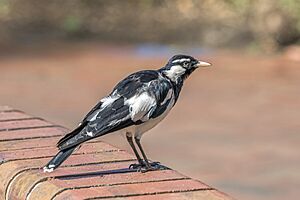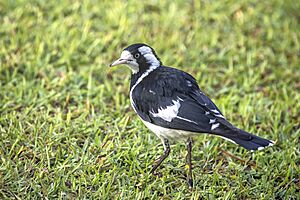Magpie-lark facts for kids
Quick facts for kids Magpie-lark |
|
|---|---|
 |
|
| male G. c. cyanoleuca, Adelaide | |
 |
|
| female G. c. neglecta, Darwin | |
| Conservation status | |
| Scientific classification | |
| Genus: |
Grallina
|
| Species: |
cyanoleuca
|
 |
|
| Distribution shown in green | |
| Synonyms | |
|
|
The magpie-lark (Grallina cyanoleuca) is a bird found in Australia, Timor, and southern New Guinea. People also call it the wee magpie, peewee, peewit, or mudlark. Both male and female magpie-larks are black and white. However, their patterns are a bit different.
A scientist named John Latham first described this bird in 1801. For a long time, people thought it belonged to the mudnest builder family. Now, scientists have placed it in the family Monarchidae, which are monarch flycatchers. There are two types, or subspecies, of magpie-larks.
Contents
About the Magpie-Lark's Name and Family
The magpie-lark was first named Corvus cyanoleucus in 1801. This was done by an English bird expert, John Latham. The name cyanoleucus comes from ancient Greek words. Cyanos means "dark blue" and leukos means "white." Even though the bird is black and white, its black feathers can sometimes look a bit bluish.
Early settlers in Australia called it the magpie-lark. This name stuck, even though other names were used. Some other names for the bird include mudlark and peewee. These names often came from how the bird builds its nest or the sounds it makes. For example, "peewee" sounds like its call.
In 1977, the RAOU officially named it the Australian magpie-lark. This helped make sure everyone used the same name.
There are two main types of magpie-larks:
- G. c. cyanoleuca: This type lives in western, central, eastern, and southern Australia.
- G. c. neglecta: This type is found in northern Australia.
Scientists used to think the magpie-lark was part of the mudnest builder family. But now, they know it belongs to the Monarchidae family. This family includes monarch flycatchers. The magpie-lark and its close relative, the torrent lark, are unique within this family. They branched off early from other monarchs.
What Does a Magpie-Lark Look Like?
The magpie-lark is a small to medium-sized bird. It grows to be about 25 to 30 centimeters (10 to 12 inches) long. This is about the same size as a European common blackbird. Magpie-larks are easy to spot because they are boldly black and white.
It's simple to tell the difference between a male and a female. The female has a white throat. The male has a black throat and a white "eyebrow" stripe above its eye. Young birds have a white throat like the female. They also have a black eye-stripe like the male. Their belly is white.
Where Do Magpie-Larks Live?
The magpie-lark is a very common bird. You can find it in cities and in the countryside. It lives in almost all parts of Australia. The only places it doesn't live are Tasmania and some desert areas in Western Australia. These birds have adapted very well to living near humans.
You can also find magpie-larks in southern New Guinea and on the island of Timor. In 1924, some magpie-larks were brought to Lord Howe Island. This island is about 600 kilometers (370 miles) east of Australia. Now, they are common there too.
You often see magpie-larks sitting on telephone wires. They might be alone or in pairs. They also look for food on bare ground, especially near water or swamps. They have even been seen in New Zealand once, but this is very rare.
Magpie-Lark Behavior and Habits
Magpie-larks mainly eat small creatures. They can live in many different places. They just need some soft, bare ground to find food. They also need mud to build their nests and a tree to build it in. Farming has actually helped these birds. Clearing forests and providing water in dry areas has created good places for them to find food.
Sometimes, you can see groups of magpie-larks together. Dozens of them might sit on high spots. They often sit near houses or on fences. This helps them mark their territory and look for mates. Their loud, high-pitched calls can sometimes be annoying to people living nearby. This behavior is common, especially in towns and rural areas. It might be related to finding a mate or just mean there's a lot of food in the area.
Magpie-larks are very protective of their territory. They will bravely defend their home against bigger birds. This includes magpies, ravens, kookaburras, and even the large wedge-tailed eagle.
They are also known to attack people to protect their nests. While their attacks are not as strong as some other birds, they can still be surprising or cause minor scratches. Magpie-larks sometimes attack mirrors, windows, and other shiny surfaces. They think their reflection is another bird trying to enter their territory.
Magpie-Lark Reproduction and Life Cycle
Magpie-larks usually stay with the same partner for their whole lives. They work together to defend their territory. Their nest is round, about 150 millimeters (6 inches) across. It has straight sides. They usually build it on a flat tree branch near water. Sometimes they build it on a telephone pole.
The nest is made of grass and plants. They use a lot of mud to hold it together. The inside is softly lined with grass, feathers, and fur. Magpie-larks breed when conditions are good. This is usually from August to February in warmer areas. In drier places, they breed after it rains. They often have more than one group of babies if conditions allow.
Both parents take turns sitting on the eggs. They lay between three and five eggs. The eggs hatch after about 18 days. The young birds are ready to fly about three weeks after hatching. Sometimes, not all the chicks survive. This can happen if the nest is too small for all the babies. One chick might push another out of the nest, and it might not survive the fall.
Because of climate change, Australia is having warmer summers and milder winters. This means magpie-larks are now breeding for longer periods during the year.
Magpie-Lark Duet Singing
Magpie-larks are one of about 200 bird species known to sing in a duet. This means two birds sing together. Each bird sings about one note per second. But they sing half a second apart. This makes it hard for humans to tell that two birds are singing, not just one.
Scientists used to think that duet singing helped birds defend their territory or stay together as a pair. For magpie-larks, we now know their duet singing is cooperative. Pairs sing together to protect their territory. They sing louder when they hear duet calls from other birds. They sing even louder if the other birds are strangers, not their usual neighbors.
If neighbor birds call from the "wrong" place (like from a recording), magpie-larks react very strongly. This shows they know exactly who their neighbors are. Magpie-larks also do "fake" duets when nesting. One bird will copy the sounds of its missing partner. This makes other birds think two birds are still there.
Images for kids
See also
 In Spanish: Grallina australiana para niños
In Spanish: Grallina australiana para niños









